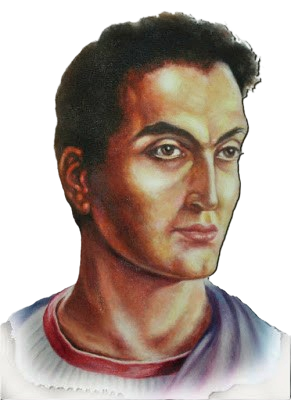
Emmanuel became known in the Spiritist community for being the spirit guide of the medium Francisco Cândido Xavier, accompanying Chico throughout his earthly journey. Together, they fulfilled the mission of publishing over 400 psychographed (writing under the spirit influence) books, in which many spirits took part in their creation. Notable contributors included Emmanuel himself, André Luiz, Humberto de Campos, Maria João de Deus (Chico’s mother), Neio Lúcio, and renowned Portuguese and Brazilian poets.
In 1931, Emmanuel first presented himself to Chico, inviting the medium to undertake the mission of psychographing/writing Spiritist books. However, for this task to proceed, Emmanuel set three fundamental conditions for Chico: discipline, discipline, and more discipline.
Emmanuel’s moral stature becomes evident when considering his mission since the early days of Spiritist Doctrine. He belonged to the phalanx of the Spirit of Truth, present in the Spiritist Codification. In Allan Kardec’s “The Gospel According to Spiritism,” a message from Emmanuel, received in Paris in 1861, titled “Selfishness” (Chapter 11, Item 11), was included.
Through his works, Emmanuel provides readers the opportunity to understand the evolutionary process in which we are all involved by sharing some of his incarnations in books psychographed by Chico Xavier. These works offer a glimpse into the evolutionary struggle of this spirit across some of his existences. Subsequently, we will recount some of the lives attributed to Emmanuel.
Roman Senator Publius Lentulus
Among Emmanuel’s various earthly incarnations, the most renowned was when he was known as Publius Cornelius Lentulus, whose physical appearance Emmanuel chose to present himself to Chico. The story of this incarnation was beautifully recorded in the book “Two Thousand Years Ago”, where Emmanuel recounted details of this existence as a Roman senator who lived during Jesus’s time on Earth. Publius was a cultured and upright man for his time, yet proud. He had a significant encounter with Jesus when he sought the master’s help to cure his daughter Flavia, who suffered from leprosy. Despite the remarkable encounter with Jesus, Publius did not attribute his daughter’s cure to the miracle performed by the master. Furthermore, his pride and mistrust also distanced him from his faithful wife Livia, who loved him in a pure and sincere manner, thus squandering the encounter life had offered him with a human being of high moral stature.
Slave Nestorius
In the second biographical book, “Fifty Years Later”, Emmanuel described the incarnation that followed the previous one as Publius Lentulus. Fifty years after his time as Publius, Emmanuel reincarnated in Ephesus, Greece, not in the distinguished role of a senator but as a slave named Nestorius. In this narrative, Emmanuel already displayed the lessons learned from his previous life, presenting himself as a wise and modest Christian.
Philosopher Basilius
Another incarnation was recounted in the book “Hail, Christ!”, where Emmanuel was Basilius, a Roman born to Greek slaves. Around the year 233, he lived in Cyprus as a freedman, devoting himself to philosophical studies. He married the slave Junia Glaura and had a daughter, but both died prematurely. Later, Basilius adopted an abandoned child found in a basket, whom he named Livia, living with her until his final days. To support his adopted daughter, Basilius became a musical instrument tuner, relocating to Marseille, where he raised her. Basilius died tortured in Lyon during the government of Trebonian Galus in Gaul after the persecution of Christians from the local church.
Priest Manuel da Nóbrega
In 1971, during the renowned TV show “Pinga-Fogo” on the now-defunct TV Tupi, Chico Xavier confirmed that Emmanuel was the Jesuit priest Manuel da Nóbrega. Manuel da Nóbrega was born in Entre-Douro-e-Minho, Portugal, in the year 1517. In 1541, he obtained a bachelor’s degree in Canon Law and Philosophy from the University of Coimbra. Three years later, he came to Brazil under the orders of the Society of Jesus with the mission of protecting and converting the indigenous people to the Christian faith, as well as founding churches and seminaries. In 1552, he accompanied Governor Tomé de Sousa to the captaincy of São Vicente and, two years later, contributed to the founding of São Paulo. Father Manuel da Nóbrega played a fundamental role in the establishment of Salvador and Rio de Janeiro, and his letters to superiors are historical documents about colonial Brazil and Jesuit action in the 16th century. Father Manuel da Nóbrega passed away in Rio de Janeiro in 1570 at the age of 53.
Father Damiano
As mentioned in the book “Renunciation”, which was psychographed by Chico Xavier, is revealed by Emmanuel to have reincarnated in 1613 in Spain. At the age of 50, he lived in Ávila, Castilla-la-Velha, serving as a priest at the Church of São Vicente. During the inception of the Holy Office, he espoused alternative ideas, actively opposing the fanaticism of the Catholic Church and the political directives of the Inquisition. He ardently believed in the soul’s immortality and the concept of multiple existences. Despite dedicating himself to the Catholic ministry, he profoundly embraced the principles of Spiritist Doctrine, even prior to its emergence in the 19th century. He passed away in Paris at an advanced age.
Educator Jean Jacques Turville
Emmanuel was also Jean Jacques Turville, born in the 18th century in France. In this life, Emmanuel served as an educator to the nobility and a Roman Catholic prelate before the French Revolution, residing in northern France. During the revolution, he fled to Spain, where he lived until his death.
Father Amaro
There’s a psychographed message by Chico titled “The Catholic Priest I Was,” in which Emmanuel describes the disincarnation process of an existence where he had lived in Brazil, in the state of Pará, as Father Amaro. Father Amaro was a humble Catholic priest who lived between the 19th and 20th centuries and moved to Rio de Janeiro, dedicating himself to preaching the Gospel of Jesus, even having contact with Bezerra de Menezes. According to information from Chico Xavier, he requested this reincarnation because he felt an inner need to withdraw, to distance himself from the prominent roles he had historically experienced in his various incarnations, in order to have time and silence to meditate and study the Gospel of the divine Master.
Current Incarnation
According to information provided by Chico, we know that Emmanuel reincarnated in the year 2000 in an undisclosed city in the state of São Paulo, where he will work in the field of education. Currently, Emmanuel is 23 years old.
Besides the biographical books, the partnership between Chico Xavier and Emmanuel provided a series of books that became references in Spiritist literature, such as “Paul and Stephen,” “The Way of Light,” “Truth and Life,” “Our Bread,” “Life and Sex,” and “Vineyard of Light.” It’s worth highlighting that in the book “The Way of Light,” Emmanuel elucidates the history of civilization in the light of Spiritism, succinctly and comprehensively.
We hope that the content of this post not only serves as inspiration for your journey here on Earth but also encourages you to read and study the various works of Emmanuel left through Chico Xavier’s psychography. Within them lie treasures of knowledge and balms for human suffering. We hope they touch your heart as they touched ours.
Sources: O Consolador, Passatempo Espírita, Federação Espírita Brasileira (FEB) and Wikipedia
Did you like our content? Subscribe to our newsletter and follow us on Instagram to stay informed about new content and updates.
Check out some related posts:
👉Who Was Chico Xavier?
👉 Who was Joanna de Ângelis?
👉Who was Allan Kardec?
👉 What is Spiritism? 8 Curiosities about Spiritism.
👉 Summary on Spiritism (Part I).
👉 10 Tips of movies and series
👉 How did the Spirits communicate with Kardec?
